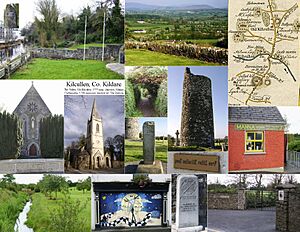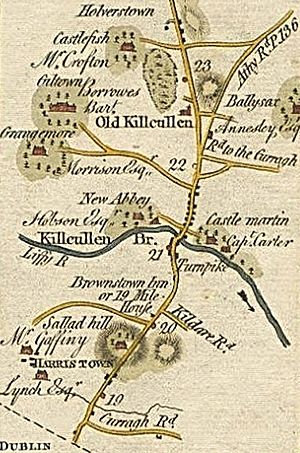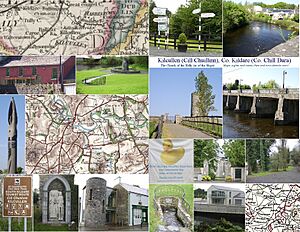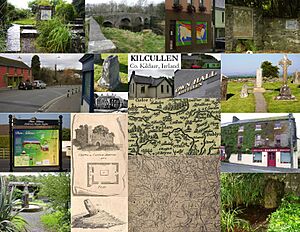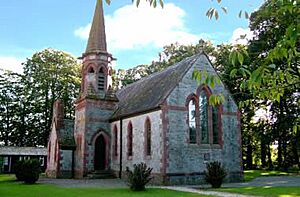Kilcullen facts for kids
Quick facts for kids
Kilcullen
Irish: Cill Chuilinn
|
|
|---|---|
|
Town
|
|
| Country | Ireland |
| Province | Leinster |
| County | County Kildare |
| Elevation | 114 m (374 ft) |
| Population
(2022)
|
3,815 |
| Time zone | UTC+0 (WET) |
| • Summer (DST) | UTC-1 (IST (WEST)) |
| Irish Grid Reference | N839095 |
Kilcullen (Irish: Cill Chuilinn), also known as Kilcullen Bridge, is a small town in County Kildare, Ireland. It sits on the River Liffey. In 2022, about 3,815 people lived there. This made it the 13th largest town in County Kildare. Between 2002 and 2011, Kilcullen was one of the fastest-growing towns in the county. Its population more than doubled during that time.
The town of Kilcullen Bridge grew up around a big bridge. This bridge was built centuries ago. It replaced an older settlement called Old Kilcullen. Important historical places nearby include Dun Ailinne, New Abbey, and Castlemartin. Many stud farms, where horses are bred, are also found in the area around Kilcullen.
Contents
Where is Kilcullen?
Kilcullen is located near the M9 motorway. This motorway connects Dublin to Waterford. The town is between Naas and Kilkenny. It is centered where two regional roads, the R413 and R448, meet. The R448 used to be the main road from Dublin to Carlow, Kilkenny, and Waterford. However, the M9 motorway opened in 1995, bypassing the town.
Kilcullen is about 40 kilometers (25 miles) from the center of Dublin. It is also close to Newbridge, Kildare town, and Naas. The town has one main bridge over the River Liffey. This bridge is on the site of the original historic bridge. It was first built in the 1310s. The bridge was last rebuilt around 1850 and made wider in the early 1970s. If you look from downstream, you can still see its old style.
The town has one main street. A few smaller roads connect to it. The main street slopes down to the Liffey and then back up again. Schools and churches are mostly at the southwestern edge. Businesses are along the main street and near the old market square. The town hall, a theatre, and a heritage center are just northeast of the bridge.
Kilcullen's Story
Old Kilcullen: The First Town
The modern town of Kilcullen and the area around it are named after an older settlement. This older town, now called Old Kilcullen, is on a hilltop a few kilometers south. It started as a place where monks lived in the mid-5th century. At its busiest, it was a walled town with seven gates. Today, only a damaged round tower and a churchyard remain.
Old Kilcullen might have been connected to Dun Ailinne. Dun Ailinne was a special place for ceremonies and possibly a palace for the kings of Leinster. Old Kilcullen was attacked by Vikings at least twice, in 936 and 944. The Vikings landed where the modern town is now.
How the Town Began
The current town, officially called Kilcullen Bridge, grew after 1319. That year, a church leader named Maurice Jakis built a bridge over the River Liffey here. Over the next few centuries, this new settlement became more important than Old Kilcullen. Early maps show the new town was completely on the eastern side of the Liffey.
The Eustace Family's Influence
The Eustace family played a big role in Kilcullen's history. One of their main homes was at Castlemartin.
The 1700s and 1800s
Kilcullen was near the Battle of Kilcullen during the 1798 Rebellion. The British Army used Castlemartin as their base in Kildare.
By 1837, the town had about 699 people. It had one main street with 112 buildings. There was a market every Saturday and several fairs throughout the year. The town also had a police station and a place for medical care. At that time, more people still lived in the countryside around Old Kilcullen than in the new town.
Historic Places to See
About three kilometers (nearly 2 miles) south of Kilcullen (Bridge) is the site of the original settlement, Old Kilcullen. Here you can find an old church, a graveyard, and a tall, circular round tower.
Old Kilcullen might have been linked to Dun Ailinne. Dun Ailinne is believed to be where the Kings of Leinster had a palace or held important ceremonies. Local groups have created a special area for Dun Ailinne at Nicholastown. It has a sculpture by a local artist. This site was officially opened in 2008. There are hopes that Dun Ailinne could become a World Heritage Site.
To the west of town is Castlemartin Estate. This estate includes Castlemartin House, an 18th-century mansion. It has about thirty rooms and is owned by an American billionaire. The estate also has St. Mary's Church, which was founded around 1200. It was restored in 1979–1980. While the estate is mostly private, there are plans for some parts to be open to the public.
Kilcullen also has an early church called New Abbey. It is about 1 kilometer (0.6 miles) outside the town. It was started in 1486 by Rowland FitzEustace, a powerful leader. Today, the abbey's remains are in a churchyard with old tombstones. You can reach it by a path through the Valley Community Park. This path also goes past St. Bridget's Well.
Near the Brannockstown and Harristown areas is Harristown House. This house was built in 1740. It was damaged by fire in 1891 but was rebuilt. Today, it is open for visitors. It has a walled garden, old furniture, and 18th-century Chinese wallpaper.
The First Toll Road
Kilcullen Bridge and Old Kilcullen were important for Ireland's first toll road. This road started in 1729. It ran to "the Bridge at Kilcullen." People had to pay a fee to use it.
The Birth of Motor Racing
On July 2, 1903, the Gordon Bennett Cup race passed through Kilcullen. This was the first international motor race ever held in what was then the United Kingdom of Great Britain and Ireland. Racing was illegal on British public roads. So, Ireland was chosen as the place for the race. Kildare was picked because its straight roads were thought to be safer.
As a special gesture to Ireland, the British team raced in Shamrock green. This color then became known as British racing green. The race route went through Kilcullen, Kildare, Monasterevin, Stradbally, Athy, Castledermot, and Carlow. The race was 328 miles (528 kilometers) long. A Belgian driver named Camille Jenatzy won the race in a Mercedes car. Today, signs mark the race route and the old inn used as a base.
Town Hall and Heritage
The town hall in Kilcullen has historical displays. These displays are put together by the Kilcullen Heritage Group. They include old photographs, prints, maps, and some objects. The Heritage Group also holds regular meetings and talks about local history.
Community and Activities
A special part of Kilcullen is the Valley Community Park. This park runs along the River Liffey. It has walking paths, one of which goes all the way to New Abbey. In the Valley, you can find the restored historic water source for the town, called the Spout. There is also the Holy Well of St. Brigid, which has a sculpture of "St. Brigid feeding the poor."
There is also a smaller Riverside Walk behind the Town Hall.
Kilcullen Library is a branch of Kildare County Libraries. It is located in the old boys' schoolhouse, built in 1925. The library has books for adults and children, local history information, and public computers.
Community Groups
Many community groups have been formed in Kilcullen over the years. These groups have done a lot for the town. For example, they helped create and protect the Valley Community Park.
Kilcullen has an active Lions Club. They help fund many community projects. One of their big fundraising events is the Duck Race in the Liffey. This race is part of a larger River Festival.
There is also a local Scout group and a well-known credit union. The Kilcullen Flower and Garden Club is also active.
Camphill Community
The Kilcullen area is home to two Camphill Communities. These communities support people with special needs. One is at Dunshane, and the other is in the town itself. The town community runs An Tearmann, which has a coffee shop and an organic food shop.
Education
Kilcullen and its surrounding area have several primary schools. There is also one secondary school, the Cross and Passion College. A Steiner method school is located nearby in Grangebeg.
Local Media
The Bridge is a local magazine that has been published monthly for a long time. The area is also covered in a section of the Kildare Nationalist newspaper. There is also an online journal called A Kilcullen Diary.
Religion
Kilcullen is the main part of the Parish of Kilcullen and Gormanstown in the Roman Catholic Church. It has two churches. The main parish church, dedicated to the Sacred Heart and St. Brigid, was built in 1872. The other church, St. Joseph's, is at Yellow Bog. There is also a church on private land at Castlemartin Estate, called St. Mary's Church.
Kilcullen is also part of the Union of Newbridge in the Church of Ireland. It has one of that Union's three churches, St. John's.
Additionally, Kilcullen has a Baptist church in Brannockstown. This church was founded in 1873.
Local Businesses
Kilcullen has over thirty shops and service places. These include a petrol station, several convenience stores (one with the local post office), and a bookshop. You can also find farm, hardware, and building equipment suppliers. There are small restaurants, fast food places, and at least three pubs that serve food. A coffee shop and bookshop are run by the local Camphill Community. Berney Bros. Saddlery, a company that makes saddles, has been on Lower Main Street since the mid-1800s.
Sports and Recreation
Kilcullen GAA is the local club for Gaelic Athletic Association sports. Kilcullen AFC is the local soccer group. The GAA club is next to the Kilcullen Community Centre Sports Complex. This complex has an all-weather pitch and an 18-hole pitch-and-putt club called St. Brigids. On the other side of town is Kilcullen Tennis Club.
There is also a successful badminton club in the area. Its members compete in tournaments and championships.
A 4.1-kilometer (2.5-mile) Sli na Slainte walking route goes around the area. It passes the graveyard, St. Bridget's Well, the bridge, and Bishop Rogan's Park.
Horses and Breeding
Kilcullen is about 6 kilometers (3.7 miles) from the Curragh. The Curragh is the main center for horse racing in Ireland. Kilcullen is home to the Aga Khan's horse breeding farm, the Gilltown Stud. Horse riding is available, and horses can be kept at local stables.
River Activities
The Liffey at Kilcullen is known for trout angling (fishing). The North Kildare TSAA manages fishing rights in the area.
Kilcullen is also home to the oldest canoe club in Ireland. It was started in 1957. Many Olympic and international kayak athletes have come from this club. Kilcullen Canoe Club has won the Irish Marathon Canoeing Cup. In 2008, the club opened its new clubhouse. It is located just upstream of The Bridge. The club encourages local people to get involved in canoeing.
Well-Known People from Kilcullen
- Abraham Boulger, a soldier who received the Victoria Cross
- Hazel Gaynor, an English author
See also
 In Spanish: Kilcullen para niños
In Spanish: Kilcullen para niños



